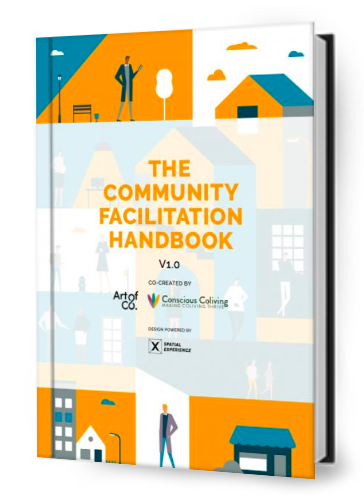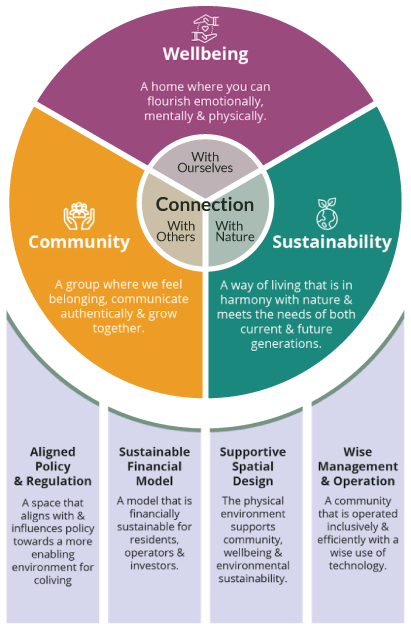The Community Facilitation Handbook is a holistic framework to make communities flourish:
- Enhance resident engagement, satisfaction, retention and brand loyalty
- Learn the dos and don'ts of community facilitation
- Implement community building best practices into your strategies
- Understand community in the context of coliving

Peer-reviewed to be the most comprehensive resource specifically catering to the creation of strong and impactful coliving communities around the world.
Co-created for you with 💚 by
Handbook design powered by
Spatial Experience
Share the Community Facilitation Handbook v1.0
Download & Leverage the Community Facilitation Handbook
Download the handbook here:
Meet the Contributors
Meet the Community Facilitation Handbook Authors
Community Facilitation Training
- Develop new tools and improve your community facilitation skills
- Create higher engagement with your community and enhance experience
- Develop bespoke community strategies
- Connect with and learn from other community facilitators
Bespoke Community Support
- Gain clarity on community strategy
- Improve resident and community experience
- Identify what is working and what is not
- Reduce turnover rates and costs
- Develop a roadmap to make your community thrive!
Community Building & Community Facilitation
FAQs
What is coliving?
A ‘basic’ definition of coliving can be described as “three or more people who are not related by blood, marriage or adoption choosing to share residential space” (Perdrix, 2019). When we think of coliving, we think of it as conscious coliving, which we define as:
a new take on an old way of shared living which promotes a culture of connection and flourishing, in which individuals and the collective share resources and an intention of living sustainably and harmoniously with each other and the planet.
Read more on the Coliving 2022 Guide.
Why invest in Community Building?
From a resident viewpoint, community contributes to wellbeing, personal growth, discovery, and feeling of belonging. The important topic of why invest in community is explored further in the Art of Co & Conscious Coliving partnership announcement article, as well in our coliving investment page.
Community living can also make daily life easier and more efficient. For instance, residents can share cooking and childcare, borrow things from one another, and support each other in times of need.
From an operator viewpoint, community offers several cost savings. These include:
- Reduction of acquisition costs
- Reduction in maintenance costs a
- Reduction in event costs
- Lower vacancy and acquisition expenses
In addition, it is important to invest in community because most coliving spaces make it part of their branding promise to their residents. If a space lacks authentic community, then there is a brand integrity issue, which will lead to a negative reputation and long-term business damage.
Find out more in Section 1.4
How can we define a successful Community?
The authors of The Community Facilitation Handbook define community as “a group where we feel belonging, communicate authentically, and grow together.” Here we highlight three of the essential components for what a successful community looks like:
- Shared Values: The root of a strong community is its shared values and how those values are expressed, communicated, and acted upon amongst its members. Coliving spaces with members that share an intention to live more sustainably for instance, often experience stronger community engagement than spaces without a shared goal.
- Psychological Safety: The term psychological safety refers to a “shared belief held by members of a team that the team is safe for interpersonal risk taking.” This notion of risk taking and the feeling of support from others is crucial to successful communities. By creating environments built on trust, coliving operators can ensure that residents will engage with one another meaningfully and authentically.
- Sustained Engagement: regular engagement and collaboration is key for any successful community or organisation. Coliving communities with weekly sponsored dinners or other shared weekly activity, for instance, tend to nurture strong communal ties necessary for a successful community.
See Section 1.3 to see what The Community Facilitation Handbook v1.0 contributors say about community!
What is the role of a Community Facilitator?
We define the role of the Community Facilitator as: “a person responsible for community building by facilitating group interactions, open communication and bridging the gap between community needs and operational processes.
Their ultimate goal is to support the emergence and maintenance of community by enabling residents to foster authentic connection, fulfill their individual needs and catalyse collective engagement.”
Discover how Community Facilitators across several coliving spaces define their role in Section 2.2.3
In what stages of the resident journey does the Community Facilitator play a role?
In order to fulfill their duties, the Community Facilitator has different responsibilities across different stages of the user journey:
- Resident onboarding: welcoming and integrating the resident within the community, while contributing to the improvement of the onboarding experience with community experience and operations teams;
- Ensuring resident wellbeing: ensuring the appropriate systems and containers are in place to allow for residents to feel emotionally and physically well and safe;
- Community development: facilitating the flourishing of the community and its activities, empowering residents to be involved and take ownership of events, initiatives, communal budget allocation, resident meetings and engagement with local neighbourhoods;
- Conflict resolution: preventing potential tensions between residents and facilitating the resolution of communal tensions on both an individual and collective level;
- Product development: working with different departments (operations, marketing, design) to improve the overall user experience and concept based on resident feedback.
What are the skillsets needed from Community Facilitators?
The following skills are required for a qualified Community Facilitator:
- Soft Skills: empathy, emotional intelligence, deep listening, clear communication, group facilitation, applied leadership, playfulness.
- Hard skills: general project management and self-organisation, event planning and management, user experience design and customer journey mapping; first aid and emergency.
- Profile Criteria: Solution finder, self-awareness, emotional stability, social character, flexibility
Check out Section 2.2.4 for more details about these skills. The Community Facilitation Handbook also offers a sample job template that you can use to recruit a Community Facilitator.
What is a Community Facilitator NOT responsible for?
One of the biggest challenges for Community Facilitators is an overload of tasks. Here are some roles that do NOT pertain to the Community Facilitator:
- Sales
- Marketing
- Customer support issues
- Building maintenance
- Operations
Read more in Section 2.2.1
Why Community Facilitation and not only Community Management?
We believe that organic community and human relationships cannot be managed, but rather facilitated. The primary difference between a Community Facilitator and a Community Manager is their mindset.
Whilst historically, the hospitality industry has tried to create engagement and entertainment with a top-down mindset, the role of a Community Facilitator is precisely to facilitate the process of community building by helping to build relationships and maintain strong group dynamics.
Read more in Section 1.1
What are some of the major mistakes in the Community Building process?
Some of the most common mistakes to avoid in developing a coliving community include a) having a weak onboarding process, b) underestimating the importance of curation, and c) architectural and design fallacies.
Regarding the role of the Community Facilitator specifically, mistakes often include a) misunderstanding the role of the Community Facilitator, b) not setting enough clear boundaries and expectations, and c) not seeing the Community Facilitator as part of the community.
Take a look at Section 2.3 for more detailed descriptions of these challenges and ways to overcome them.
What are ways to manage conflict within a community space?
Conflict is inherent in community and tensions cannot be avoided. There is often a fine line that Community Facilitators need to tread between facilitating conflict and getting too involved. Many coliving spaces choose to stay away from the intermediary process of meddling in the concerns of members. However, there are several conflict-management frameworks and communication tools for Community Facilitators to be familiar with and offer to residents.
Nonviolent Communication (NVC)
Beginning Anew
Radical Candor
Find out more in Section 3.7
What are tools that can be used for collective decision making?
One of the biggest challenges in building community is figuring out how to make and take decisions that feel fair and inclusive. The participatory decision-making tools listed below (and fleshed out in The Community Facilitation Handbook v1.0) can help your community make better decisions and be used during group events or continuously as a technological enhancement to in-person gatherings.
- Which Alternative is Elected (Whale4)
- Loomio
- Gradients of Agreement
Read more about these tools in Section 3.2
What are strategies for encouraging Community Engagement?
- The Community Facilitation Handbook outlines several tools and activities to support group bonding and create a safe space to share between individuals. These include:
- Community assemblies
- Collective Intelligence Workshops
- Sharing/Talking Circles
- Hotseats
- Masterminds
- Connection with nature
- Shared meals
- Wellbeing practices
- Transformational events
Read more in Sections 3.3, 3.4, 3.5, and 3.6
How can technology be integrated for Community Building?
The potential (and challenges) of technology for community facilitation and resident experience are further explored in the Coliving Apps, Software & Technology Guide, as well in Naima’s article for Coliving Insights Nº5.
Technology can be used to streamline operations and ultimately enhance community experience in coliving spaces. As this handbook has shown, facilitating community requires a blend of ‘softwares’ and ‘hardwares’, and technology solutions exist to help operators manage their spaces. These include tech tools related to:
- Property Management System
- Access Control
- Connectivity Solutions
- Roommate Matching
- Booking Platforms
Find out more in Section 3.8
Wellbeing + Sustainability + Community
How can coliving communities truly fulfil their full potential?
And what would the impact on the world be if they did?
Back in 2018 Conscious Coliving came together to explore these questions,
creating the first version of The Conscious Coliving Manifesto, now on its version 3.0.
Connection with
Ourselves, Others & Nature
can be achieved through:





















